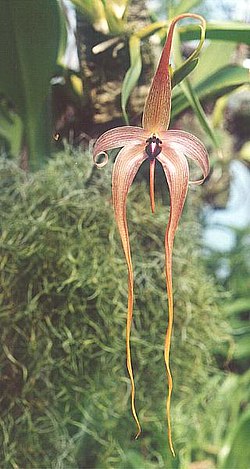Bulbophyllum
| Habit | orchid |
|---|
|
houars > |
If this plant info box on watering; zones; height; etc. is mostly empty you can click on the edit tab and fill in the blanks!
Bulbophyllum is the largest genus in the orchid family Orchidaceae. With 1803 species, it is also one of the largest genera in the entire plant kingdom, exceeded only by Senecio and Euphorbia. This genus is abbreviated in the trade journals as Bulb.
This genus was first described by Louis-Marie Aubert du Petit-Thouars (botanical abbreviation Thouars) in his book "Histoire particulière des plantes orchidées recueillies sur les trois Iles Australes d’Afrique, de France, de Bourbon et de Madagascar", describing 17 Bulbophyllum species. There are now more than 2,800 records (accepted names and synonyms) for this genus. This large number and the great variety of its forms make this genus a real nightmare for a taxonomist: 120 sections and subgenera have been listed. Some of these may deserve a generic status. Several species have as many as ten synonyms. Up to now a general review of this genus is lacking. But as Carlyle A. Luer of Missouri Botanical Garden disentangled the similar chaos in the Pleurothallidinae, so we may expect that a phylogenetic study of this genus will gain us a better insight in this large genus.[citation needed]
The scientific name has been derived from the Latin word bulbus (bulb-like) and the Greek word phyllon (leaf), referring to the pseudobulbs on top of which the leaf is growing.
Two small Australian species, the previous B. globuliforme and B. minutissimum, were placed in 1961, in a new genus, Oncophyllum, of which they are the only members, and are now named Oncophyllum globuliforme and Oncophyllum minutissimum.[1]
The center of diversity of this genus is in the montage forests of Papua New Guinea (more than 600 species) which seems to be the evolutionary[citation needed] homeland, though the genus is pantropical and widespread occurring in Australia, Southeast Asia with over 200 species in Borneo), Africa Madagascar (with 135 species, some endemic) and in tropical central and South America.
The general characteristics for this genus are : single-noded pseudobulbs, the basal inflorescence and the mobile lip.
This genus covers an incredible range of vegetative forms, from tall plants with cane-like stems, to root climbers that wind or creep their way up tree trunks. Other members are pendulous epiphytes (growing on other plants), and quite a number that have developed succulent foliage to a greater or lesser degree. Some species are lithophytic. One species has almost become leafless and uses its pseudobulbs as the organs of photosynthesis.
These orchids with a sympodial growth have rhizomatous stems with often angled pseudobulbs. The thin to leathery leaves are folded lengthwise.
Many Bulbophyllum species have the typical odor of rotting carcasses, and the flies they attract assist in their reproduction through pollination.
The erect to pendent inflorescence arises laterally from the base of the pseudobulb. The flower form has a basic structural blueprint that serves to identify this genus. But this form can be very diverse : compound or single, with few to many flowers, with the resupinate flowers arranged spirally or in two vertical ranks. The sepals and the petals can also be very varied : straight or turned down, without footstalk or with a long claw at the base. They are often hairy of callous. There are two to four hard and waxy pollinia with stipes present or absent. The fruits are beakless capsules.
ExpandRead about Bulbophyllum in the Standard Cyclopedia of Horticulture
|
|---|
Cultivation
Propagation
Pests and diseases
Species
1805 species, including:
Bulb. barbigerum (Bearded Bulbophylllum)
Bulb. beccarii
Bulb. crassulifolium (Wheat-leaved Bulbophyllum)
Bulb. falcatum
Bulb. flaviflorum (Golden comb orchid)
Bulb. fletcherianum (Tongue Orchid)
Bulb. globuliforme
Bulb. macphersonii
Bulb. macraei (Wu-lai cirrous orchid)
Bulb. makayanum (Daisy orchid)
Bulb. medusae
Bulb. pachyrhachis (Rattail orchid)
Bulb. purpurea (Lizard Orchid)
Bulb. retusiusculum (Yellow comb orchid)
Bulb. transarisanense (Lily orchid)
Some species are known for their extremes of vegetive and floral form:
- Bulbophyllum beccarii
- Bulbophyllum barbigerum
- Bulbophyllum falcatum
- Bulbophyllum macphersonii
- Bulbophyllum medusae
New species are being discovered every year, such as
- Bulbophyllum ciluliae Bianch. & J.A.N.Bat., Sitientibus 2004
- Bulbophyllum orezii Sath.Kumar 2004
There is one intergeneric hybrid : Triasphyllum (abbr.: Tphm.) (Bulbophyllum x Trias)
A number of Bulbophyllum species are threatened with extinction, and are recognised as such by the World Conservation Union (IUCN):
- Bulbophyllum bifarium, Vulnerable
- Bulbophyllum filiforme, Critically endangered
- Bulbophyllum gravidum, Vulnerable
- Bulbophyllum jaapii, Vulnerable
- Bulbophyllum kupense, Critically endangered
- Bulbophyllum modicum, Endangered
- Bulbophyllum nigericum, Vulnerable
- Bulbophyllum pandanetorum, Endangered
- Bulbophyllum rubrolabellum, Endangered
- Bulbophyllum tokioi, Endangered
genus synonyms include:
- Anisopetalum Hkr. 1825.
- Bolbophyllaria Rchb.f 1852.
- Bolbophyllum Spreng. 1826.
- Cochlia Bl. 1825.
- Didactyle Lindley 1852.
- Diphyes Bl. 1825.
- Ephippium Blume 1825.
- Epicranthes Bl. 1825.
- Epicrianthes Bl. 1828.
- Gersinia Neraud. 1826.
- Henosis Hkr.f 1890.
- Katherinea A. D. Hawkes 1956.
- Lyraea Lindl. 1830.
- Macrolepis A. Rich. 1834.
- Malachadenia Lindley 1839.
- Megaclinium Lindley 1826.
- Odontostyles Breda 1827.
- Osyricera Bl. 1825.
- Oxysepala Wight 1851.
- Phyllorchis Thou. 1822.
- Sarcopodium Lindley & Paxton 1850.
- Sestochilos Breda 1828.
- Sunipia Lindley 1826.
- Taurostalix Rchb.f. 1852.
- Tribrachia Lindley 1824.
- Xiphizusa Rchb.f 1852.
- Zygoglossum Reinw. 1826 [1828].
Gallery
References
- ↑ D.L.Jones et M.A.Clements, Orchadian 13(9): 421 (2001).
- Standard Cyclopedia of Horticulture, by L. H. Bailey, MacMillan Co., 1963
External links
- w:Bulbophyllum. Some of the material on this page may be from Wikipedia, under the Creative Commons license.
- Bulbophyllum QR Code (Size 50, 100, 200, 500)





